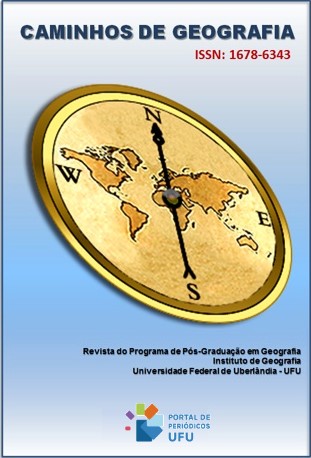GEOPROCESSAMENTO E REDES NEURAIS CONVOLUCIONAIS: ANÁLISE DA COBERTURA E USO DA TERRA NA BACIA HIDROGRÁFICA DO RIO ALMADA (BAHIA – BRASIL)
DOI:
https://doi.org/10.14393/RCG2510172917Palavras-chave:
Aprendizagem profunda, Visão computacional, Análise geoespacial, Sistema da informação geográfica, Sensoriamento remotoResumo
As técnicas de geoprocessamento associadas aos modelos de Redes Neurais Convolucionais (CNN) emergem como uma alternativa viável para a obtenção de dados que possam subsidiar a tomada de decisões. Neste contexto, este trabalho tem como objetivo avaliar a aplicação de algoritmos de CNN para a classificação e detecção das classes de cobertura e uso da terra nas imagens de satélite da Bacia Hidrográfica do Rio Almada (BHRA). Para alcançar o objetivo, são estruturadas etapas lógicas: (i) coleta de informações; (ii) processamento do dataset EuroSat; e, (iii) a avaliação dos modelos. Os resultados da classificação demonstram precisões superiores a 90% no reconhecimento das classes. Quanto ao modelo de detecção, identifica-se uma precisão de 70% para as classes “Forest” e “Pasture”, que têm grandes extensões dentro da BHRA. Ambos os modelos evidenciaram sua versatilidade na aplicação e na viabilidade como ferramentas de monitoramento das condições físicas e ambientais da BHRA. Nesse sentido, ressalta-se a eficácia dos modelos na identificação e localização das classes de cobertura e uso da terra, enfatizando a importância da construção de um dataset que evidencia as características da área de estudo. Isso contribui para a obtenção de resultados confiáveis, aprimorando a utilidade prática dos modelos de CNN.
Downloads
Downloads
Publicado
Edição
Seção
Licença
Copyright (c) 2024 Hercules da Silva Carvalho, Vinícius de Amorim Silva, Paulo Sérgio Vila Nova Souza

Este trabalho está licenciado sob uma licença Creative Commons Attribution-NonCommercial-NoDerivatives 4.0 International License.
Autores que publicam nesta revista concordam com os seguintes termos: a) Autores mantém os direitos autorais e concedem à revista o direito de primeira publicação, com o trabalho licenciado sob a Creative Commons Atribuição-NãoComercial-SemDerivações 4.0 Internacional. b) Autores têm permissão e são estimulados a publicar e distribuir seu trabalho online (ex.: em repositórios institucionais ou na sua página pessoal), já que isso pode gerar alterações produtivas, bem como aumentar o impacto e a citação do trabalho publicado. c) Em virtude de aparecerem nesta revista de acesso público, os artigos são de uso gratuito, com atribuições próprias, em aplicações educacionais e não-comerciais.











